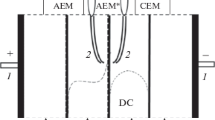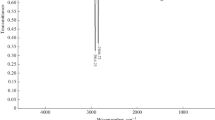Abstract
A series of anion-exchange membranes based on a Neosepta AMX-Sb homogeneous membrane (Japan) have been studied by applying parallel nonconducting strips of a 100 to 600 μm width with the interstrip distance ranging from 400 to 1900 μm. The current–voltage characteristics of the membranes and the pH of a NaCl solution (of 0.02 mol/L concentration) have been measured in the course of passing the solution through the desalination compartment of a flow-through electrodialysis cell. Two sets of membranes with a nonconducting surface fraction snc of 5 to 60%, in which the pattern steps on the surface are 1000 and 2000 μm, have been considered. It has been shown that the limiting current density, ilim, depends on the nonconducting surface fraction: ilim exceeds the corresponding value for the initial membrane in the case when snc is in the range from 5 to 20%, reaching a maximum approximately at snc = 10% followed by a decrease with the further increase in snc. At snc = 10%, the value of ilim is greater when the inhomogeneity step is 2000 μm. It has been assumed that the growth in both the limiting current density and the rate of mass transfer through the modified membranes is due to electroconvection. The obtained experimental results correlate well with known mathematical models describing ion transport in membrane systems with allowance for electroconvection in the case of homogeneous and heterogeneous membranes.







Similar content being viewed by others
REFERENCES
J.-H. Choi and S.-H. Moon, J. Membr. Sci. 191, 225 (2001).
E. Volodina, N. Pismenskaya, V. Nikonenko, et al., J. Colloid Interface Sci. 285, 247 (2005).
Y. Tong, S. Bohm, and M. Song, Appl. Surf. Sci. 424, 72 (2017).
C. Amatore, J. M. Saveant, and D. Tessier, J. Electroanal. Chem. 147, 39 (1983).
C. Amatore, C. Pebay, C. Sella, and L. Thouin, ChemPhysChem 13, 1562 (2012).
K. R. Ward, N. S. Lawrence, R. S. Hartshorne, and R. G. Compton, Phys. Chem. Chem. Phys. 14, 7264 (2012).
I. Rubinstein, B. Zaltzman, and T. Pundik, Phys. Rev. E: Stat. Nonlinear, Soft Matter Phys. 65, 1 (2002).
V. I. Zabolotskii, V. V. Bugakov, M. V. Sharafan, and R. Kh. Chermit, Russ. J. Electrochem. 48, 650 (2012).
M. Svoboda, J. Benes, L. Vobecka, and Z. Slouka, J. Membr. Sci. 525, 195 (2017).
V. I. Vasil’eva, N. A. Kranina, M. D. Malykhin, et al., Poverkhnost’, No. 2, 51 (2013).
E. M. Akberova, E. Yu. Kozhukhova, A. M. Yatsev, and V. I. Vasil’eva, Kondens. Sredy Mezhfazn. Granitsy 19, 158 (2017).
S. M. Davidson, M. Wessling, and A. Mani, Sci. Rep. 6, 22505 (2016).
V. I. Zabolotskii, L. Novak, A. V. Kovalenko, et al., Pet. Chem. 57, 779 (2017).
S. S. Dukhin and N. A. Mishchuk, Kolloid Zh. 49, 1197 (1987).
I. Rubinstein, Phys. Fluids A 3, 2301 (1991).
S. S. Dukhin, Adv. Colloid Interface Sci. 35, 173 (1991).
N. A. Mishchuk, Colloids Surf., A 140, 75 (1998).
R. Kwak, G. Guan, W. K. Peng, and J. Han, Desalination 308, 138 (2013).
V. V. Nikonenko, S. A. Mareev, N. D. Pis’menskaya, et al., Russ. J. Electrochem. 53, 1122 (2017).
V. I. Vasil’eva, A. V. Zhil’tsova, M. D. Malykhin, et al., Russ. J. Electrochem. 50, 134 (2014).
E. Korzhova, N. Pismenskaya, D. Lopatin, et al., J. Membr. Sci. 500, 161 (2016).
Y. Mizutani, J. Membr. Sci. 49, 121 (1990).
N. A. Mel’nik, K. A. Shevtsova, N. D. Pis’menskaya, and V. V. Nikonenko, Kondens. Sredy Mezhfazn. Granitsy 12, 233 (2010).
J.-H. Choi and S.-H. Moon, J. Colloid Interface Sci. 265, 93 (2003).
R. J. Williamson. http://digitalcommons.fiu.edu/etd/3055.
D. Golubenko, Y. Karavanova, and A. Yaroslavtsev, J. Electroanal. Chem. 777, 1 (2016).
N. A. Mel’nik, Extended Abstract of Candidate Dissertation in Chemistry (Krasnodar, 2011).
M. K. Urtenov, A. M. Uzdenova, A. V. Kovalenko, et al., J. Membr. Sci. 447, 190 (2013).
E. D. Belashova, N. A. Melnik, N. D. Pismenskaya, et al., Electrochim. Acta 59, 412 (2012).
V. V. Gil, M. A. Andreeva, N. D. Pismenskaya, et al., Pet. Chem. 56, 440 (2016).
E. I. Belova, G. Yu. Lopatkova, N. D. Pismenskaya, et al., J. Phys. Chem. B 110, 13458.
E. Güler, W. van Baak, M. Saakes, and K. Nijmeijer, J. Membr. Sci. 455, 254 (2014).
K. A. Nebavskaya, V. V. Sarapulova, K. G. Sabbatovskiy, et al., J. Membr. Sci. 523, 36 (2017).
C. Larchet, S. Nouri, B. Auclair, et al., Adv. Colloid Interface Sci. 139, 45 (2008).
V. V. Nikonenko, V. I. Vasil’eva, E. M. Akberova, et al., Adv. Colloid Interface Sci. 235, 233 (2016).
V. V. Umnov, N. V. Shel’deshov, and V. I. Zabolotskii, Russ. J. Electrochem. 35, 871 (1999).
V. S. Pham, Z. Li, K. M. Lim, et al., Phys. Rev. E: Stat. Nonlinear, Soft Matter Phys. 86, 1 (2012).
N. A. Mishchuk, Adv. Colloid Interface Sci. 160, 16 (2010).
I. Rubinstein and B. Zaltzman, Phys. Rev. E: Stat. Phys., Plasmas, Fluids, Relat. Interdiscip. Top. 62, 2238 (2000).
J. Newman and K. E. Thomas-Alyea, Electrochemical Systems (Wiley, New York, 2004).
ACKNOWLEDGMENTS
This work, performed at the Russian–French International Associated Laboratory of Ion-Exchange Membranes and Processes, was supported by the Russian Foundation for Basic Research, project no. 16-38-00794 mol_a. The authors thank the Core Facility “Environmental Analytical Center” of the Kuban State University (unique identifier RFMEFI59317Х0008) for providing their equipment.
The authors thank Dr. A.E. Kozmai for assistance in preparing drawings.
Author information
Authors and Affiliations
Corresponding authors
Additional information
Translated by S. Zatonsky
Rights and permissions
About this article
Cite this article
Nebavskaya, K.A., Butylskii, D.Y., Moroz, I.A. et al. Enhancement of Mass Transfer Through a Homogeneous Anion-Exchange Membrane in Limiting and Overlimiting Current Regimes by Screening Part of Its Surface with Nonconductive Strips. Pet. Chem. 58, 780–789 (2018). https://doi.org/10.1134/S0965544118090086
Received:
Published:
Issue Date:
DOI: https://doi.org/10.1134/S0965544118090086




